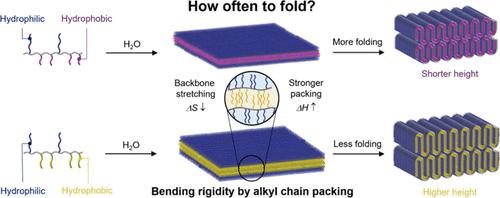通过弯曲刚度控制调节双层折叠薄片的折叠高度
IF 5.2
1区 化学
Q1 POLYMER SCIENCE
引用次数: 0
摘要
我们研究了两亲性无规共聚物水溶液中出现的双层折叠片层(Lf)介相。我们通过低聚(乙二醇)丙烯酸酯与具有从辛基(C8)到十八烷基(C18)不同烷基链长的丙烯酸烷基酯的可逆加成-碎片链转移共聚合成了一系列共聚物。丙烯酸烷基酯的成分在 50-60 mol % 之间调节。在烷基侧链碳数大于 10 的浓溶液中,共聚物在水中通过烷基链之间的疏水作用产生胶束双分子层,并周期性地折叠成双分子层状。小角 X 射线散射(SAXS)峰出现在与 10 nm 长度尺度相对应的低散射矢量处,这清楚地区分了双层折叠薄片与域间距为 5-7 nm 的胶束薄片。二维(2D)SAXS证实了双层折叠薄片垂直于胶束薄片的存在,这与我们之前的报告一致。在室温下观察到十二烷基(C12)和十四烷基(C14)侧链形成无定形堆积的 Lf 相,而结晶的十六烷基(C16)和十八烷基(C18)侧链似乎会干扰双层折叠。将溶液加热至高于烷基链的熔化温度,可产生 Lf 相,其中 C16 的折叠高度最大。折叠高度与碳数的比例关系支持了双分子层的弯曲刚度影响折叠长度尺度的观点。本文章由计算机程序翻译,如有差异,请以英文原文为准。

Tuning of Folding Height in Bilayer-Folded Lamellae by Bending Rigidity Control
We investigated the bilayer-folded lamellar (Lf) mesophase appearing in the aqueous solution of amphiphilic random copolymers. A series of copolymers were synthesized by reversible addition–fragmentation chain transfer copolymerization of oligo(ethylene glycol) acrylate with alkyl acrylate with different alkyl chain lengths from octyl (C8) to octadecyl (C18). The alkyl acrylate composition was adjusted between 50–60 mol %. In the concentrated solution with the carbon number of the alkyl side chain higher than 10, the copolymers associated in water via hydrophobic interaction between the alkyl chains to produce micellar bilayers, which were periodically folded into bilayer-folded lamellae. The appearance of a small-angle X-ray scattering (SAXS) peak at a low scattering vector corresponding to >10 nm length scale clearly distinguished the bilayer-folded lamellae from the micellar lamellae with the domain spacing of 5–7 nm. Two-dimensional (2D) SAXS corroborated the presence of bilayer-folded lamellae developing perpendicularly to the micellar lamellae, which is consistent with our previous report. While the Lf phase was observed at room temperature for dodecyl (C12) and tetradecyl (C14) side chains that formed amorphous packing, crystalline hexadecyl (C16) and octadecyl (C18) chains seem to disturb bilayer folding. Heating the solution above the melting temperature of the alkyl chains produced the Lf phase with the largest folding height in the case of C16. The scaling relationship of the folding height to the carbon number supports the idea that the bending rigidity of the bilayer influences the length scale of folding.
求助全文
通过发布文献求助,成功后即可免费获取论文全文。
去求助
来源期刊

Macromolecules
工程技术-高分子科学
CiteScore
9.30
自引率
16.40%
发文量
942
审稿时长
2 months
期刊介绍:
Macromolecules publishes original, fundamental, and impactful research on all aspects of polymer science. Topics of interest include synthesis (e.g., controlled polymerizations, polymerization catalysis, post polymerization modification, new monomer structures and polymer architectures, and polymerization mechanisms/kinetics analysis); phase behavior, thermodynamics, dynamic, and ordering/disordering phenomena (e.g., self-assembly, gelation, crystallization, solution/melt/solid-state characteristics); structure and properties (e.g., mechanical and rheological properties, surface/interfacial characteristics, electronic and transport properties); new state of the art characterization (e.g., spectroscopy, scattering, microscopy, rheology), simulation (e.g., Monte Carlo, molecular dynamics, multi-scale/coarse-grained modeling), and theoretical methods. Renewable/sustainable polymers, polymer networks, responsive polymers, electro-, magneto- and opto-active macromolecules, inorganic polymers, charge-transporting polymers (ion-containing, semiconducting, and conducting), nanostructured polymers, and polymer composites are also of interest. Typical papers published in Macromolecules showcase important and innovative concepts, experimental methods/observations, and theoretical/computational approaches that demonstrate a fundamental advance in the understanding of polymers.
 求助内容:
求助内容: 应助结果提醒方式:
应助结果提醒方式:


